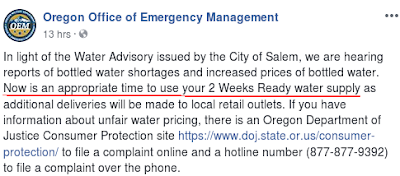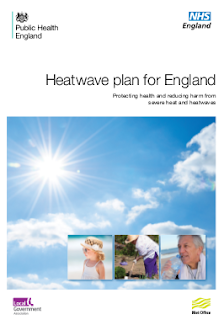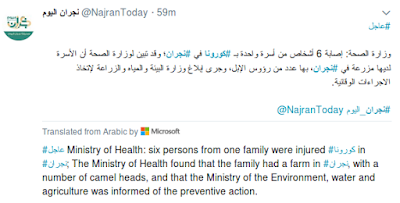#13,344
Although the Saudi MOH website hasn't been updated in more than two weeks, for the past 3 days FluTrackers and I been following unofficial reports of a cluster of MERS cases in the southern town of Najran, near the Yemen border (see Tuesday's More On The Silence Of The Saudis).
While the details have varied in these reports - citing anywhere from 6 to 12 cases - they all reportedly belonged to a single household.Today we appear to have confirmation of at least 7 cases following the publication of an email from the Saudi Assistant Deputy Minister for Preventive Health - Abdullah Assiri - by ProMed Mail.
31 May 2018 MERS-CoV (19): Saudi Arabia (NJ) household cluster conf.
Date: 31 May 2018
From: Abdullah Assiri[edited]
MERS update, Kingdom of Saudi Arabia
------------------------
[1] 23 May 2018
New case ID: 18-1711
MERS in Najran city: 45-year-old male living in Najran city, Najran Region.
Date of onset: [17 May 2018]
Date of hospital admission: [20 May 2018]
Diagnosis: MERS pneumonia with ARDS [acute respiratory distress syndrome], critical
Contact tracing: 11 household contacts listed for follow-up
Contact with camels and consumption of raw milk.
Ministry of Agriculture has been informed, and investigation of camels is ongoing.
Case classification: community acquired/primary
[2] 27 May 2018
New case ID: 18-1712
MERS in Najran city: 39-year-old male living in Najran city, Najran Region.
Date of onset: [22 May 2018]
Date of hospital admission: [25 May 2018]
Diagnosis: MERS URTI [upper respiratory tract infection], stable
Case classification: community acquired/secondary (household to 18-1711)
[3] 28 May 2018
New case ID: 18-1713
MERS in Najran city: 46-year-old male living in Najran city, Najran Region.
Date of onset: [26 May 2018]
Date of hospital admission: [27 May 2018]
Diagnosis: MERS URTI, stable
Case classification: community acquired/secondary (household to 18-1711)
[4] 28 May 2018
New case ID: 18-1714
MERS in Najran city: 19-year-old male living in Najran city, Najran Region.
Date of onset: [26 May 2018]
Date of hospital admission: [27 May 2018]
Diagnosis: MERS URTI, stable
Case classification: community acquired/secondary (household to 18-1711)
[5] 29 May 2018
New case ID: 18-1715
MERS in Najran city: 28-year-old male living in Najran city, Najran Region.
Date of onset: [27 May 2018]
Date of hospital admission: [28 May 2018]
Diagnosis: MERS URTI, stable
Case classification: community acquired/secondary (household to 18-1711)
[6] 29 May 2018
New case ID: 18-1716
MERS in Najran city: 31-year-old male living in Najran city, Najran Region.
Date of onset: [27 May 2018]
Date of hospital admission: [28 May 2018]
Diagnosis: MERS URTI, stable
Case classification: community acquired/secondary (household to 18-1711)
[7] 30 May 2018
New case ID: 18-1717
MERS in Najran city: 52-year-old male living in Najran city, Najran Region.
Date of onset: [27 May 2018]
Date of hospital admission: [28 May 2018]
Diagnosis: MERS URTI, stable
Case classification: community acquired/secondary (household to 18-1711)
--
Abdullah Assiri
Assistant Deputy Minister for Preventive Health
Kingdom of Saudi Arabia
[ProMED-mail would like to thank Dr. Abdullah Assiri for clarifying the information from the media report we posted yesterday (30 May 2018) (see MERS-CoV (18): Saudi Arabia (NJ) susp. family cluster, RFI 20180530.5829389). According to the official records provided by Dr. Assiri, there is an ongoing household cluster of MERS-CoV infection in Najran involving a primary case (case No. 1 above), a 45-year-old male from Najran, currently in critical condition, with a history of direct contact with camels and raw camel products (milk) and 6 additional contacts in stable condition with symptoms of an acute upper respiratory tract infection out of 11 identified household contacts.
This cluster is occurring in Najran, the capital city of the Najran region, located in the southwest of Saudi Arabia. The region shares a border with Yemen.















